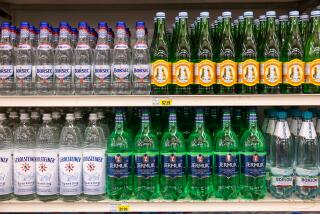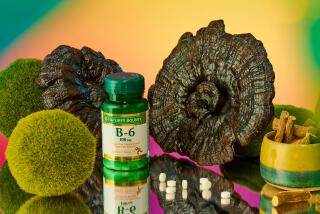Energy Drinks Surge in Popularity
- Share via
Gene La Pietra has surfed constantly changing beverage trends during 30 years of serving up drinks at bars and clubs in Hollywood. But few waves have been as dramatic as the arrival of energy drinks--nonalcoholic beverages loaded with caffeine, vitamins and other ingredients designed to provide a quick pick-me-up.
The imported Red Bull energy drink is so hot that the club owner built a new bar at Circus Disco in Hollywood that sells only chilled 8.3-ounce cans of the Austrian beverage at $4 a pop. “When I first saw that tiny little can, I thought [Red Bull] was crazy,” La Pietra said. “I didn’t think anybody would buy it. But they gave it a chic, high-end promotion that makes it seem exclusive--so everyone wants to have it.”
Red Bull’s popularity is part of a beverage industry transformation being driven by consumers who are increasingly as likely to ask their favorite bartender for a pricey bottle of water or a tangy fruit drink as a frosty draft or a glass of merlot.
“A lot of old rules and distinctions are falling away,” said Rodney Sacks, chairman of Hansen Natural Corp., the Corona-based soft drink company. “People are looking for different drinks, so a lot of lines end up getting crossed, particularly in bars.”
Beverage companies that prided themselves on knowing exactly what consumers want are scrambling to sate the public’s thirst for variety.
* Brewer Anheuser-Busch will roll out an energy drink in January, just the third time in recent decades that the St. Louis-based king of beers has marketed a nonalcoholic beverage.
* Hansen Natural is introducing Hard E, a malted beverage that contains 5% alcohol.
* Carbonated drink king Coca-Cola Co. soon will unveil KMX, a lightly carbonated energy drink that’s loaded with caffeine, ginseng, Vitamin B and carbohydrates.
* In deals valued at more than $13 billion, PepsiCo Inc. has acquired South Beach Beverage, owner of the trendy Lizard Fuel and Liz Blizz drinks, and Quaker Oats, owner of the fast-growing Gatorade line. The deals follow the 1998 acquisition of Tropicana, a deal that lessened the No. 2 cola company’s reliance upon carbonated drinks.
Beverage companies are struggling to keep tabs on younger consumers’ rapidly changing lifestyles and values, said Tom Pirko, president of Bevmark, a Santa Barbara consulting firm. “When young people go into a 7-Eleven, nobody knows what they’re going to pick up--and that’s a clear warning for big companies like Anheuser-Busch.”
Consumer demand for a wider variety of thirst quenchers is part of a broader trend--what PepsiCo Chairman Roger Enrico describes as “the continued deconstruction of meals . . . more and more people are getting their nutritional and caloric intake on an ongoing basis . . . one-handed meals, on-the-go eating.”
Coke and Anheuser-Busch might also draw flak from health experts who generally frown upon the concept of caffeinated beverages loaded with vitamins being pitched as energy drinks. And at least one Southern California high school doesn’t want energy drinks on campus.
“If these drinks are taking the place of beer or soft drinks, then it’s certainly a lesser evil,” said Robert Girandola, a USC professor of exercise science. “But the United States is one of the most over-vitaminized people in the world. Probably the last thing we need is an energy drink.”
Energy drinks also can generate negative publicity when they’re consumed by youngsters. Red Bull and other energy drinks recently were banned from the John Burroughs High School campus in Burbank after two football players experienced dizziness and high heart rates after consuming beverages purchased at a nearby convenience store.
Assistant Principal Jay Gudzin, who purchased three different energy drinks--including Red Bull--said the labels include language indicating that the drinks aren’t intended for children. “As far as we’re concerned, that means our students should not be consuming these products,” he said.
The nation’s biggest beverage companies also must deal with the fact that, for some young bar-goers, energy drinks are an attractive way to complement increasingly popular drugs such as Ecstasy. At trendy bars, for example, Red Bull is gaining a reputation as a popular mixer with vodka.
Big companies aren’t abandoning their core businesses as they track changing consumer tastes, however. Anheuser-Busch, for example, controls 47.5% of the beer market. The segment’s 1999 growth rate was four times higher than the yearly rate during the previous eight years.
But if Anheuser-Busch’s One-Eighty energy drink succeeds, the brewer’s exclusive distributors--who generate 60% of its annual beer sales--will have a product to counter Red Bull.
Advertising for One-Eighty will target upscale consumers as they move from “morning and afternoon ‘pick-me-ups’ to pre- and post-workout routines, to night-clubbing,” said Anheuser-Busch Vice President Steve Bagwell.
Targeting upscale consumers is just half of Anheuser-Busch’s bid to produce a new, profitable product. The brewer hopes to enjoy economies of scale because energy drinks have “a similar consumer base as beer,” said Gary Hemphill, vice president of Beverage Marketing Corp., a New York consulting firm. “It makes sense because energy drinks are sold in many of the same outlets as their beer.”
That’s the same philosophy guiding PepsiCo, which has been lessening its dependence upon carbonated beverages. Non-fizzy drinks are growing at an 8% to 9% annual clip, far outdistancing the carbonated sector’s 2% to 3% annual growth rate.
During a Dec. 4 telephone conference call with industry analysts, PepsiCo’s Enrico boasted that the $13-billion Quaker Oats deal gives his company a share of the noncarbonated sector that’s “1.5 times the next largest player . . . and it’s not just the starting point we’re excited about, it’s the growth prospects.”
Coca-Cola Co., which at the last moment backed away from a deal to acquire Quaker Oats last month, also is searching for alternative beverages outside of its core business. “Coca-Cola remains our flagship brand, our No. 1 priority,” said Coca-Cola spokeswoman Susan McDermott. “But we now consider ourselves a beverage company. We’re looking for all the opportunities that we can find where we can participate.”
Atlanta-based Coke’s newest player is KMX, a citrus-flavored drink with a “chili bite”. It’s also is introducing a frozen coffee beverage that will be sold through convenience stores and fast-food restaurants, and will bring Santa, a popular fruit-flavored drink sold elsewhere in the world, to the U.S. market.
“One big focus under our new management is identifying existing opportunities where we might not yet be competing, as well as looking for brands that can be extended to the U.S.,” McDermott said. “And we’re also looking to create new categories.”
Hansen’s Hard E, which will have a suggested retail price of $1.99 to $2.49 per bottle, “will be marketed in bars, then liquor stores and finally the [retail] chains,” Sacks said. “It’s being marketed as a ready-mix drink.”
Beverage industry players don’t want to risk their core brands, so they’re exercising caution as they cross the beverage aisle. Hansen Natural created Hard E to market the new malt beverage, and Anheuser-Busch’s name appears only in small type on the back of the One-Eighty can.
The brewer of the Budweiser, Michelob and Busch beers has reason to move slowly. It has introduced just two other nonalcoholic beverages in the last 30 years, Zeltzer Seltzer and Root 66, both of which died quick deaths. “Anheuser-Busch has stuck its toe into the [nonalcoholic] beverage market a long time ago and quickly pulled it out,” Pirko said. “The water can get pretty cold.”
More to Read
Eat your way across L.A.
Get our weekly Tasting Notes newsletter for reviews, news and more.
You may occasionally receive promotional content from the Los Angeles Times.









